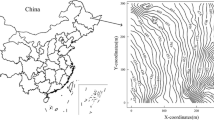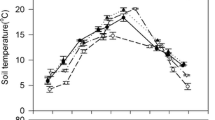Abstract
We investigated the causes for the seasonal and spatial variation of soil respiration in a first rotation Sitka spruce chronosequence composed of four age classes (10, 15, 31, and 47 year old) in Central Ireland. The study aimed at identifying easily determinable environmental parameters that explained the variation in soil respiration rates. The variation in temperature and soil water content influenced the seasonal trend observed in the spatial variability of soil respiration. The highest coefficients of variation in soil respiration were observed during autumn drought, while lower coefficients were generally observed during periods with highest soil respiration rates. On average, the sampling strategy of 30 sampling points per stand was adequate to obtain an average rate of soil respiration within 20% of its actual value at the 95% confidence level. Significantly higher soil respiration rates were observed at locations with high accumulation of organic matter and in collars established in close vicinity to tree stems. The organic layer thickness was the only variable that yielded significant regressions for explaining spatial variation in soil respiration in all the stands. Correlation analyses between the studied variables and soil respiration suggested the relative importance of heterotrophic and autotrophic components differed in their annual contribution to total soil respiration at each forest stand. Multiple regression analyses were used to assess the relative importance of primary temporal and spatial controls over soil respiration. Soil temperature and organic layer thickness explained most of the variance of soil respiration for the different sampling periods, while soil water content had a weaker effect as well as a different influence on soil respiration depending on the time of the year. The strong linear correlation between forest floor carbon and soil carbon stock further confirmed organic layer thickness as an integrative factor encompassing the effect of soil carbon pools on soil respiration. Moreover, its inclusion in the multiple regression analyses overrode the influence of both distance and fine root biomass. Overall, a multiple linear regression model driven by easily determinable environmental variables such as soil temperature, organic thickness, soil water content, soil bulk density, and soil organic carbon concentration allowed us to explain 54% of total variance of soil respiration over the different stand ages for the entire year (P < 0.05). Our results show that the adoption of an adequate sampling strategy, and the determination of some key environmental variables may help to explain a large proportion of total variation of soil respiration over the entire rotation length of afforested ecosystems.
Similar content being viewed by others
References
Ben-Asher J, Cardon GE, Peters D, Rolston DE, Biggar JW, Phene CJ, Ephrath JE (1994) Determining root activity distribution by measuring surface carbon dioxide fluxes. Soil Sci Soc Am J 58:926–930
Ben-Dor E, Banin A (1989) Determination of organic matter content in arid-zone soils using a simple ‘loss on ignition’ method. Commun Soil Sci Plan 15&16:1675–1695
Bhupinderpal-Singh, Nordgen A, Ottosson Löfvenius M, Högberg MN, Mellander P-E, Högberg P (2003) Tree root and soil heterotrophic respiration as revealed by girdling of boreal Scots pine forest: extending observations beyond the first year. Plant Cell Environ 26:1287–1296
Blake GR, Hartge KH (1986) Bulk density. In: Klute A (Ed), Methods of soil analysis Part 1. Physical and mineralogical methods, American Society of Agronomy. Madison, Wisconsin. USA pp 363–375
Boone RD, Nadelhoffer KJ, Canary JD, Kaye JP (1998) Roots exert a strong influence on the temperature sensitivity of soil respiration. Nature 396:570–572
Buchmann N (2000) Biotic and abiotic factors controlling soil respiration rates in Picea abies stands. Soil Biol Biochem 32:1625–1635
Butterbach-Bahl K, Rothe A, Papen H (2002) Effect of tree distance on N2O and CH4 fluxes from soils in temperate forest ecosystems. Plant Soil 240:91–103
Curiel Yuste J, Janssens IA, Carrara A, Meiresonne L, Ceulemans R (2003) Interactive effects of temperature and precipitation on soil respiration in a temperate maritime pine forest. Tree Physiol 23:1263–1270
Davidson EA, Belk E, Boone RD (1998) Soil water content and temperature as independent or confounded factors controlling soil respiration in a temperate mixed hardwood forest. Glob Change Biol 4:217–227
Davidson EA, Savage K, Verchot LV, Navarro R (2002) Minimizing artifacts and biases in chamber based measurements of soil respiration. Agric For Meteorol 113:21–37
Davidson EA, Verchot LV, Cattânio JH, Ackerman IL, Carvalho JEM (2000) Effects of soil water content on soil respiration in forests and cattle pastures of eastern Amazonia. Biogeochemistry 48:53–69
Epron D, Farque L, Lucot É, Badot P-M (1999) Soil CO2 efflux in a beech forest: dependence on soil temperature and soil water content. Ann For Sci 56:221–226
E.S.F. (2000) Investigating the role of soils in the terrestrial carbon balance, harmonising methods for measuring soil CO2 efflux. European Science Foundation (Exploratory Workshop), Edinburgh, 6–8 April 2000
Fang C, Moncrieff J (1999) A model for soil CO2 production and transport 1: model development. Agric For Meteorol 95:225–236
Fang C, Moncrieff JB, Gholz HL, Clark KL (1998) Soil CO2 efflux and its spatial variation in a Florida slash pine plantation. Plant Soil 205:135–146
Ford ED, Deans JD (1978) The effects of canopy structure on stemflow, throughfall and interception loss in a young Sitka spruce plantation. J Appl Ecol 15:905–917
Hanson PJ, Edwards NT, Garten CT, Andrews JA (2000) Separating root and soil microbial contributions to soil respiration: a review of methods and observations. Biogeochemistry 48:115–146
Högberg P, Nordgren A, Buchmann N (2001) Large-scale forest girdling shows that current photosynthesis drives soil respiration. Nature 411:789–792
Janssens IA, Lankreijer H, Matteucci G, Kowalski AS, Buchmann N, Epron D, Pilegaard K, Kutsch W, Longdoz B, Grünwald T, Montagnani L, Dore S, Rebmann C, Moors EJ, Grelle A, Rannik ü, Morgenstern K, Oltchev S, Clement R, Guðmundsson J, Minerbi S, Berbigier P, Ibrom A, Moncrieff J, Aubinet M, Bernhofer C, Jensen NO, Vesala T, Granier A, Schulze E-D, Lindroth A, Dolman AJ, Jarvis PG, Ceulemans R, Valentini R (2001) Productivity overshadows temperature in determining soil and ecosystem respiration across European forests. Glob Change Biol 7:269–278
Kang S, Doh S, Lee D, Lee D, Jin VL, Kimball JS (2003) Topographic and climatic controls on soil respiration in six temperate mixed-hardwood forest slopes, Korea. Glob Change Biol 9:1427–1437
Kiese R, Butterbach-Bahl K (2002) N2O and CO2 emissions from three different tropical forest sites in the wet tropics of Queensland, Australia. Soil Biol. Biochem 34:975–987
Klopatek JM (2002) Belowground carbon pools and processes in different age stands of Douglas-fir Tree Physiol 22:197–204
Kuzyakov Y, Cheng W (2001) Photosynthesis controls of rhizosphere respiration and organic matter decomposition. Soil Biol Biochem 33:1915–1925
Longdoz B, Yernaux M, Aubinet M (2000) Soil CO2 efflux measurements in a mixed forest: impact of chamber disturbances, spatial variability and seasonal evolution. Glob Change Biol 6:907–917
Olsthoorn AFM, Klap JM, Voshaar JHO (1999) The relation between fine root density and proximity of stems in closed Douglas-fir plantations on homogeneous sandy soils: implications for sampling design. Plant Soil 211:215–221
Parkin TB, Kaspari TC (2003) Temperature controls on diurnal carbon dioxide flux: implications for estimating soil carbon loss. Soil Sci Soc Am J 67:1763–1772
Pregitzer KS, Zak DR, Maziasz J, DeForest J, Curtis PS, Lussenhop J (2000) Interactive effects of atmospheric CO2, and soil-N availability on fine roots of Populus tremuloides. Ecol Appl 10:18–33
Raich JW, Bowden RD, Steudler PA (1990) Comparison of two static chambers techniques for determining carbon dioxide efflux from forest soils. Soil Sci Soc Am J 54:1754–1757
Raich JW, Schlesinger WH (1992) The global carbon dioxide flux in soil respiration and its relationship to vegetation and climate. Tellus 44B:81–89
Rayment MB, Jarvis PG (2000) Temporal and spatial variation of soil CO2 efflux in a Canadian boreal forest. Soil Biol Biochem 32:35–45
Rey A, Pegoraro E, Tedeschi V, De Parri I, Jarvis PG, Valentini R (2002) Annual variation in soil respiration and its components in a coppice oak forest in Central Italy. Glob Change Biol 8:851–866
Rochette P, Desjardins RL, Pattey E (1991) Spatial and temporal variability of soil respiration in agricultural fields. Can J Soil Sci 71:189–196
Rout SK, Gupta SR (1989) Soil respiration in relation to abiotic factors, forest floor litter, root biomass and litter quality in forest ecosystems of Siwaliks in northern India Acta Oecol 10:229–244
Russell CA, Voroney RP (1998) Carbon dioxide efflux from the floor of a boreal aspen forest. I. Relationship to environmental variables and estimates of C respired. Can J Plant Sci 78:301–310
Saiz G, Byrne KA, Butterbach-Bahl K, Kiese R, Blujdea V, Farrell EP (2006) Stand age-related effects on soil respiration in a first rotation Sitka spruce chronosequence in central Ireland. Glob Change Biol. 12:1007–1020
Savage KE, Davidson EA (2003) A comparison of manual and automated systems for soil CO2 flux measurements: trade-offs between spatial and temporal resolution. J Exp Bot 54:891–899
Scott-Denton LE, Sparks KL, Monson RK (2003) Spatial and temporal controls of soil respiration rate in a high-elevation, subalpine forest. Soil Biol Biochem 35:525–534
Skopp J, Jawson MD, Doran JW (1990) Steady-state aerobic microbial activity as a function of soil water content. Soil Sci Soc Am J 54:1619–1625
Snedecor GW, Cochran WG (1967) Statistical methods, Iowa State University Press, Ames, Iowa. USA. pp 274
Stoyan H, De-Polli H, Bohm S, Robertson GP, Paul EE (2000) Spatial heterogeneity of soil respiration and related properties at the plant scale. Plant Soil 222:203–214
Widén B, Majdi H (2001) Soil CO2 efflux and root respiration at three sites in a mixed pine and spruce forest: seasonal and diurnal variation. Can J For Res 31:786–796
Wiseman PE, Seiler JR (2004) Soil CO2 efflux across four age classes of plantation loblolly pine (Pinus taeda L.) on the Virginia Piedmont. For Ecol Manage 192:297–311
Xu M, Qi Y (2001) Soil-surface CO2 efflux and its spatial and temporal variations in a young ponderosa pine plantation in northern California. Glob Change Biol 7:667–677
Acknowledgements
We gratefully acknowledge Ms. Sandra Lopez and Dr. Viorel Blujdea for their valuable work in fine root processing. We also want to express our gratitude to Mr. Fred Drion, Mr. Javier Cubillo and Mr.␣Ray Byrne for their help in setting-up the sites. We␣thank (COFORD) The Irish Council for Forestry Research and␣Development for provision of funds, and Coillte Teoranta, the Irish Forestry Board for allowing the use of its sites.
Author information
Authors and Affiliations
Corresponding author
Rights and permissions
About this article
Cite this article
Saiz, G., Green, C., Butterbach-Bahl, K. et al. Seasonal and spatial variability of soil respiration in four Sitka spruce stands. Plant Soil 287, 161–176 (2006). https://doi.org/10.1007/s11104-006-9052-0
Received:
Accepted:
Published:
Issue Date:
DOI: https://doi.org/10.1007/s11104-006-9052-0




